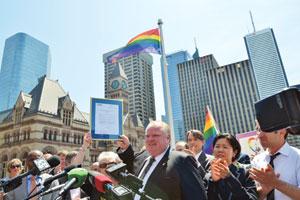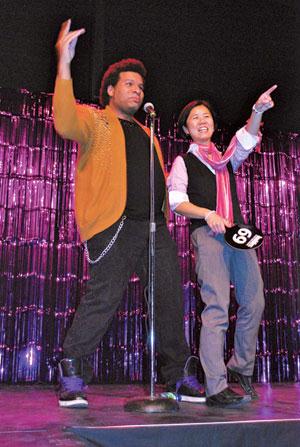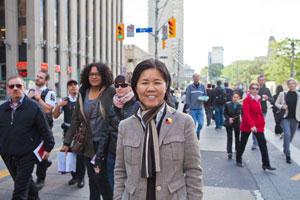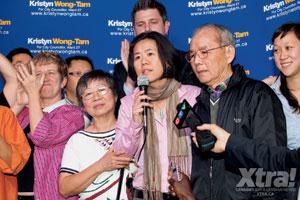
Wong-Tam helped convince Mayor Rob Ford to attend the PFLAG event commemorating International Day Against Homophobia and Transphobia on May 17, 2012. Credit: Andrea Houston

Ryan G Hinds and Wong-Tam at the 2011 Buddies in Bad Times Art Attack fundraising auction. Credit: Katie toth

Credit: Adam Coish
Not so long ago, Kristyn Wong-Tam, city councillor for Ward 27, received a peremptory call from the mayor’s office. Thomas Beyer, Rob Ford’s scheduler, wanted to speak with her. When she got there, Beyer was clearly agitated. He told Wong-Tam that a constituent had come to his office to complain that she had sanctioned posters on Church Street advocating violence against the mayor.
The poster in question did indeed show a photograph of Ford, looking blissfully heavenward. The text above his head read “Glory Hole,” and a round, black circle consumed much of the mayor’s ample midriff. The words “Boner Killer” were printed below (if readers recognize the sensibility of artist/activist Roy Mitchell at work, said readers will be correct). When she was confronted with it, Wong-Tam says she was momentarily at a loss for words (a rare phenomenon). “I was doing one of those ‘blink-blink’ things,” she says, “and thinking, ‘Are they serious?’ But they saw the word killer, decided someone was advocating killing the mayor and that I had sanctioned putting them up and down Church Street.”
Then, she found herself, as tactfully as possible, explaining the meaning of glory hole to a now rattled Beyer, a man who works for a city with the largest gay population in the country but who seemed remarkably unaware of some very common gay patois.
It was a moment that somehow pulled together the sometimes contradictory threads that weave into the life of the first openly lesbian, Chinese-Canadian politician in the country — the businesswoman and the radical, the gay woman with deep connections to gay men and their often raunchy cultural expressions (with a bunch of other queer kids, she once spent a night in a bathhouse — she passed as a cute boy and didn’t have to lie), the fierce defender of the gay community who almost always chooses to turn any possible confrontation with the toxic administration at city hall into a teaching moment. She has been much lionized, and not just by her tribe. Toronto Life magazine dubbed her The Anti-Ford in a major feature in its March issue (she was flagged on the cover as “The only sane person at city hall”), speculating that she has the qualities to run for mayor or Parliament. Not bad for a rookie councillor nearing the halfway point in her first term (she won the seat with 28 percent of the vote in November 2010 after starting the campaign as the underdog who didn’t score endorsement from outgoing councillor Kyle Rae or mayoralty hopeful George Smitherman).
•
It’s been a long honeymoon, but for some it’s reaching its best-before date. It’s not too difficult to find activists and citizens who worry that this one-time real estate agent harbours the dreaded gentrification gene, that her vision for the ward ignores its poor and focuses on condos for the well-to-do and a streetscape that politely sanitizes the much loved messiness and unpredictability of downtown life. She’s been blamed for everything from the removal of benches at Church and Alexander to supporting a ban on postering (except in designated areas), accusations which are short on fact — the benches, for example, belonged not to the city but to the Alexus condo at that corner. Wong-Tam objected to their removal, but the condo board had concerns about violence and drug dealing and, with the support of the local business and residents’ associations, took them away (Wong-Tam says she’s working on a new design for that space, involving trees, flowers, lighting and new seating, that will be complete by 2014).
The ban on postering is a Church Wellesley Village BIA initiative. Many think they’re wrong and that business shouldn’t define what constitutes the public realm. To the extent that Wong-Tam supports that model, it could be argued that she’s simply responding to constituency concerns. She did exactly that on another issue. The Homewood Maitland Safety Association had been badgering her about the sex-worker stroll on that corner, claiming that a majority of locals wanted traffic patterns reworked as a way of handling the issue. Wong-Tam took the trouble to survey residents, and it turned out a small majority was actually opposed to that solution and content to let the workers ply their trade. A politician who responds to constituency concerns by taking sides can never win, a lesson clearly not lost on Wong-Tam.
Most anti-Wong-Tam sentiment appears online, often with an unpleasant “gotcha” tone. “Take off your rose-coloured glasses” read the update on Ash Lee’s Facebook page, “and realize what this woman is: one of the strongest advocates for gentrification and the displacement of the poor we’ve got going in Toronto right now. Where’s your lefty super hero councillor now?” Many other postings amount to little more than drive-by sniping on Facebook and Twitter, but even then, do they have a point?
Indisputably, Ward 27 is a hotbed of competing, and often conflicting, interests. It’s the second most populous ward in the city. Besides the gay village, it includes the affluent citizens of Rosedale, the lower-income residents on Sherbourne south, a significant aboriginal population and half the downtown financial district. There are three police divisions — 51, 52 and 53 — and two universities: U of T and Ryerson. She hears from, and must listen to, 14 residents’ associations and the boards of 15 business improvement areas.
Wong-Tam says there are more development projects underway in Ward 27 than in any other ward in the city. WorldPride is on the horizon for 2014. No one, of course, could square a circle that complex and fractious, not even someone who sleeps only four to six hours a night and is known for her punishingly long hours on the job (Tristan Downe-Dewdney, one of her assistants, told me that city hall tends to empty out between 4:30 and 5 on most days but that Wong-Tam’s staff are often still there when the cleaners arrive).
That she’s serious about trying to do the impossible is evidenced by the fact that she surrendered her real estate licence when she got elected. There’s no going back. She could have suspended the licence, allowing her to return to her old profession if she ever wanted to, and though she’d been a real estate broker for 16 years and was about to open her own firm, she decided that she didn’t want even the appearance of a conflict of interest.
I met her first in a courtroom on University Avenue. She was there to support the Barbra Schlifer Clinic in its charter challenge to the Harper government’s bill to kill the long-gun registry (Wong-Tam had been a leader in getting council to back the effort, but the clinic’s legal ploy was not successful). She somewhat grandiosely described her presence there as a historic moment in her term as city councillor, but even given the hyperbole it’s clear she has an expansive view of her job, one that extends well beyond the pothole nitty-gritty of city politics. Just ask her: “I have big, lofty goals,” she says. (It should be pointed out that Wong-Tam is seamlessly fluent when it comes to policy wonkery. She can come across as a passionate but slightly humourless high-school civics instructor.) Those goals, lofty and otherwise, are outlined in a 30-point, five-page document entitled “Ward 27 Projects & Status Report,” and they range from the purely aspirational (“Create an open and accountable government through communication, engagement and participation”) to the practical (“implement a city-wide shark fin ban to achieve a national ban”). They also include prioritizing and working for WorldPride, creating a parks renaissance (including securing 11 Wellesley St W as a new park), expanding and improving cycling infrastructure, improving and expanding affordable housing, abolishing or reforming the Ontario Municipal Board and much, much more.
•
Two years isn’t a long time to be in office, and much of what people see happening in the ward today was started or approved before she was elected, while many of the initiatives that appear on her list are still in the planning stage, in early development or not likely to win approval given the current makeup of council (for example, her goal to protect and expand community grants for the arts and for AIDS education). Her dream of creating a Bank of Toronto is probably too visionary for the current administration (though she’s hosting a public banking forum at city hall on Oct 15). And though her motion to abolish the Ontario Municipal Board was adopted at council, the provincial government refuses to act (the OMB has the power to override planning decisions that have the support of residents and substitute plans submitted by developers). Her plan for a park in the derelict space on Wellesley also passed at council, but the government, which wants to sell the property, isn’t listening.
Council’s recent decision to remove the bike lanes on Jarvis came as a real blow, particularly since she had presented an 11-page report on the Jarvis Street Cultural Corridor that drew on community surveys to demonstrate significant support for keeping and extending the lanes.
Her most significant public success is probably Celebrate Yonge, the month-long festival that transformed sections of that busy street into a more pedestrian-friendly zone, with different “themed” areas between Gerrard and Queen streets and with patio seating serviced by local pubs and restaurants. She had also been helpful with making the Ryerson section of Gould Street into a pedestrian area with tables and chairs. She’s big on beautifying public space and has arranged for the painting of murals on construction hoarding on five development sites in the ward.
Where she’ll probably have the most impact on people’s lives is as a visionary when it comes to development and housing. It’s a challenging portfolio — developers have big money, want profits, are often willing to accommodate community concerns but have the OMB to turn to if they’re unwilling to compromise. Wong-Tam deals with them a lot.
David Bronskill is a partner at the law firm Goodmans who specializes in land use and development-related work, acting for the developer. “She puts community interests front and centre,” he says, “and isn’t shy about expressing strong opinions if she feels changes have to be made. She’s also very good at managing community expectations. It’s very rare for a councillor halfway through her first term to have that level of sophistication. She has asked for redesigns, expressed concerns about height and about how the building meets the street. She always brings a community vision to bear and works with resident associations to help them define what they want and form a consensus.” They’ve had a few disagreements, but he says that “even then, it’s an open and transparent dialogue. She learns from people even when she disagrees with them.”
She says her approach to developers is very simple — if you want her to approve a project, you have to give something back. If you’re going to make money, you have to enrich the community as well. She says she’s set new records for extracting Section 37 funds from developers (money they’re willing to pay to exceed height or density requirements) and has ploughed portions of it into rebuilding Yonge Street, into TCHC community housing, Artscape and Habitat for Humanity (at least 14 new units of affordable housing, completely integrated into the downtown fabric). She also says she tells developers that “we don’t want cookie-cutter condos that are all steel and glass. We prefer natural materials, like stone, brick and granite. We want a green strategy for every building. And in my ward, if you want to build, here’s what you have to do: 10 percent of the units have to be affordable, and 10 percent have to be three bedroom. We have to build for families as well.”
Brian Brown, vice-president with Lifetime Developments, dealt with Wong-Tam during the negotiations for a new, 50-storey condominium on Grenville Street near Yonge and College, due to be completed in the fall of 2014. “She’s very consultative,” he says, “wants feedback, wants everyone on board and accounted for. The public meetings and working groups we pulled together with her resulted in significant changes to our building’s height, the way it related to other buildings and to a heritage property we wanted to retain on the site.”
•
Of course, accolades from developers will be seen by some as a mark against her, but she’s also championed by the city’s urbanati. I spoke with Gil Penalosa, founder of 8-80 Cities, a charitable organization devoted to fostering cities that are “good for an eight-year-old and good for an 80-year-old.” He says that he and Wong-Tam align on the importance of public space and cites her Celebrate Yonge initiative as a fine example. “That was risky and it was new and no one thought it was possible under the Ford administration,” he says, “but she’s a doer. And she gets everyone involved.” (Penalosa is known for having helped organize “ciclovias,” days when cities close many streets to motorized traffic and turn them over to cyclists, pedestrians, wheelchairs and almost anything human powered. Wong-Tam told The Globe in an Oct 8 story that she intends to ask council to investigate organizing something similar for Toronto next summer.)
Michael McClelland, a principal with ERA Architects, a firm specializing in heritage conservation, urban design and cultural planning, started the Friends of Allan Gardens with her, joined her for a Jane’s Walk down Jarvis Street and often finds himself representing developers in her ward. He’s impressed by her civility, often in very tough negotiations. “She doesn’t pull punches at meetings I’ve been at,” he says, “but she’s never mean. Civility rules.”
He remembers a standoff with a developer that imperilled a heritage building. “It was very clever of her to ask to put the matter before a working committee made up of local people who were stakeholders,” he says. “Heritage was on one side, the developer on the other, but the committee negotiated a compromise that saved the building.”
Journalist John Lorinc, who frequently writes on urban issues for Spacing magazine and other publications, describes her as “grounded and unflappable, and those are important qualities in the craziness of the Ford administration. She was exemplary when it came to Pride. She worked hard to give the mayor a safe place to engage, and she could have blasted him. She doesn’t go there. She’s got things she wants to do and knows she has to work with him and the rest of council.”
Of course, the fact that she’s willing to work within the system is enough to damn her in the eyes of some. She’s been a target more than once of the confrontation tactics of the ultra-left Ontario Coalition Against Poverty, whose members see her and her “developer friends” as instrumental in a move to gentrify areas on and around Sherbourne south of Gerrard.
Gentrification. Sanitization. They are the two most common critiques levelled against Wong-Tam, sometimes by people who nonetheless end by conceding she’s one of the forces for good on council. Many who level accusations are young and likely to define gentrification as a smoothing out of the nicely jagged edges that make downtown life so louchely appealing, while senior citizens and the physically challenged almost certainly read it as encouraging safe, navigable neighbourhoods. Those visions shouldn’t be mutually exclusive, though they will be if Wong-Tam’s critics are right and the developments and initiatives that come to fruition on her watch favour development at the cost of community. The next two years will tell the tale. She’ll make mistakes, and as colleagues have told her, working with the Ford administration is like running on quicksand. But my money’s on her. •

 Why you can trust Xtra
Why you can trust Xtra


